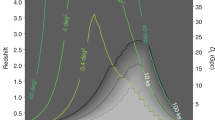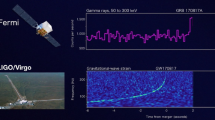Abstract
The gravitational waves (GWs) from a binary black hole with masses \(10^4\lesssim M\lesssim 10^7\mathrm{M_\odot }\) can be detected with the Laser Interferometer Space Antenna (LISA) once their orbital frequency exceeds 10\(^{-4}\)–10\(^{-5}\) Hz. The binary separation at this stage is \(a=O(100)R_{\mathrm{g}}\) (gravitational radius), and the orbital speed is \(v/c=O(0.1)\). I argue that at this stage, the binary will be producing bright electromagnetic (EM) radiation via gas bound to the individual BHs. Both BHs will have their own photospheres in X-ray and possibly also in optical bands. Relativistic Doppler modulations and lensing effects will inevitably imprint periodic variability in the EM light-curve, tracking the phase of the orbital motion, and serving as a template for the GW inspiral waveform. Advanced localization of the source by LISA weeks to months prior to merger will enable a measurement of this EM chirp by wide-field X-ray or optical instruments. A comparison of the phases of the GW and EM chirp signals will help break degeneracies between system parameters, and probe a fractional difference difference \(\Delta v\) in the propagation speed of photons and gravitons as low as \(\Delta v/c \approx 10^{-17}\).



Similar content being viewed by others
Notes
Ref. [34] considered a similar Doppler modulation that would arise following the tidal disruption of a star by a massive BBH at somewhat larger separations, but did not consider simultaneous direct measurement of GWs.
For a circular orbit; non-sinusoidal modulations from eccentric orbits are easily incorporated into the analysis.
See www.lsst.org.
D.J. D’Orazio and R. Di Stefano, in preparation.
References
Abbott, B.P., Abbott, R., Abbott, T.D., Abernathy, M.R., Acernese, F., Ackley, K., Adams, C., Adams, T., Addesso, P., Adhikari, R.X., et al.: Binary black hole mergers in the first advanced LIGO observing run. Phys. Rev. X 6(4), 041015 (2016)
Abbott, B.P., Abbott, R., Abbott, T.D., Abernathy, M.R., Acernese, F., Ackley, K., Adams, C., Adams, T., Addesso, P., Adhikari, R.X., et al.: GW151226: observation of gravitational waves from a 22-solar-mass binary black hole coalescence. Phys. Rev. Lett. 116(24), 241103 (2016)
Abbott, B.P., Abbott, R., Abbott, T.D., Abernathy, M.R., Acernese, F., Ackley, K., Adams, C., Adams, T., Addesso, P., Adhikari, R.X., et al.: Observation of gravitational waves from a binary black hole merger. Phys. Rev. Lett. 116(6), 061102 (2016)
Amaro-Seoane, P., et al.: Laser Interferometer Space Antenna. Proposal submitted to ESA (2017)
Artymowicz, P., Lubow, S.H.: Dynamics of binary-disk interaction. 1: resonances and disk gap sizes. Astrophys. J. 421, 651–667 (1994)
Artymowicz, P., Lubow, S.H.: Mass flow through gaps in circumbinary disks. Astrophys. J. Lett. 467, L77+ (1996)
Bartos, I., Kocsis, B., Haiman, Z., Márka, S.: Rapid and bright stellar-mass binary black hole mergers in active galactic nuclei. Astrophys. J. 835, 165 (2017)
Bellovary, J.M., Mac Low, M.M., McKernan, B., Ford, K.E.S.: Migration traps in disks around supermassive black holes. Astrophys. J. Lett. 819, L17 (2016)
Berti, E., Buonanno, A., Will, C.M.: Testing general relativity and probing the merger history of massive black holes with LISA. Class. Quantum Gravity 22, S943–S954 (2005)
Bloom, J.S., et al.: Astro2010 decadal survey whitepaper: coordinated science in the gravitational and electromagnetic skies. In: The Astronomy and Astrophysics Decadal Survey (2010). http://adsabs.harvard.edu/abs/2009arXiv0902.1527B
Bode, T., Haas, R., Bogdanović, T., Laguna, P., Shoemaker, D.: Relativistic mergers of supermassive black holes and their electromagnetic signatures. Astrophys. J. 715, 1117–1131 (2010)
Bowen, D.B., Campanelli, M., Krolik, J.H., Mewes, V., Noble, S.C.: Relativistic dynamics and mass exchange in binary black hole mini-disks. Astrophys. J. 838, 42 (2017)
Chartas, G., Rhea, C., Kochanek, C., Dai, X., Morgan, C., Blackburne, J., Chen, B., Mosquera, A., MacLeod, C.: Gravitational lensing size scales for quasars. Astronom. Nachr. 337, 356 (2016)
Chung, D.J., Kolb, E.W., Riotto, A.: Extra dimensions present a new flatness problem. Phys. Rev. D 65(8), 083516 (2002)
Csáki, C., Erlich, J., Grojean, C.: ESSAY: the cosmological constant problem in brane-worlds and gravitational Lorentz violations. Gen. Relativ. Gravit. 33, 1921–1927 (2001)
Cuadra, J., Armitage, P.J., Alexander, R.D., Begelman, M.C.: Massive black hole binary mergers within subparsec scale gas discs. MNRAS 393, 1423–1432 (2009)
Cutler, C., Hiscock, W.A., Larson, S.L.: LISA, binary stars, and the mass of the graviton. Phys. Rev. D 67(2), 024015 (2003)
Dai, X., Kochanek, C.S., Chartas, G., Kozłowski, S., Morgan, C.W., Garmire, G., Agol, E.: The sizes of the X-ray and optical emission regions of RXJ 1131–1231. Astrophys. J. 709, 278–285 (2010)
Deffayet, C., Menou, K.: Probing gravity with spacetime sirens. Astrophys. J. Lett. 668, L143–L146 (2007)
D’Orazio, D.J., Haiman, Z., Duffell, P., MacFadyen, A., Farris, B.: A transition in circumbinary accretion discs at a binary mass ratio of 1:25. MNRAS 459, 2379–2393 (2016)
D’Orazio, D.J., Haiman, Z., MacFadyen, A.: Accretion into the central cavity of a circumbinary disc. MNRAS 436, 2997–3020 (2013)
D’Orazio, D.J., Haiman, Z., Schiminovich, D.: Relativistic boost as the cause of periodicity in a massive black-hole binary candidate. Nature 525, 351–353 (2015)
Dubovsky, S.L., Tinyakov, P.G., Tkachev, I.I.: Massive graviton as a testable Cold-Dark-Matter candidate. Phys. Rev. Lett. 94(18), 181102 (2005)
Farris, B.D., Duffell, P., MacFadyen, A.I., Haiman, Z.: Binary black hole accretion from a circumbinary disk: gas dynamics inside the central cavity. Astrophys. J. 783, 134 (2014)
Farris, B.D., Duffell, P., MacFadyen, A.I., Haiman, Z.: Binary black hole accretion during inspiral and merger. MNRAS 447, L80–L84 (2015)
Farris, B.D., Duffell, P., MacFadyen, A.I., Haiman, Z.: Characteristic signatures in the thermal emission from accreting binary black holes. MNRAS 446, L36–L40 (2015)
Frank, J., King, A., Raine, D.J.: Accretion Power in Astrophysics, 3rd edn. Cambridge University Press, Cambridge, UK (2002)
Gold, R., Paschalidis, V., Ruiz, M., Shapiro, S.L., Etienne, Z.B., Pfeiffer, H.P.: Accretion disks around binary black holes of unequal mass: general relativistic MHD simulations of postdecoupling and merger. Phys. Rev. D 90(10), 104030 (2014)
Graham, M.J., Djorgovski, S.G., Stern, D., Glikman, E., Drake, A.J., Mahabal, A.A., Donalek, C., Larson, S., Christensen, E.: A possible close supermassive black-hole binary in a quasar with optical periodicity. Nature 518, 74–76 (2015)
Guerras, E., Dai, X., Steele, S., Liu, A., Kochanek, C.S., Chartas, G., Morgan, C.W., Chen, B.: Extended X-ray monitoring of gravitational lenses with Chandra and joint constraints on X-ray emission regions. Astrophys. J. 836, 206 (2017)
Haiman, Z.: Electromagnetic chirp of a compact binary black hole: a phase template for the gravitational wave inspiral. Phys. Rev. D 96(2), 023004 (2017)
Haiman, Z., Kocsis, B., Menou, K.: The population of viscosity- and gravitational wave-driven supermassive black hole binaries among luminous active galactic nuclei. Astrophys. J. 700, 1952–1969 (2009)
Hassan, S.F., Rosen, R.A.: Resolving the ghost problem in nonlinear massive gravity. Phys. Rev. Lett. 108(4), 041101 (2012)
Hayasaki, K., Loeb, A.: Detection of gravitational wave emission by supermassive black hole binaries through tidal disruption flares. Sci. Rep. 6, 35629 (2016)
Hayasaki, K., Mineshige, S., Sudou, H.: Binary black hole accretion flows in merged galactic nuclei. Publ. Astron. Soc. Jpn. 59, 427–441 (2007)
Jacobson, T., Mattingly, D.: Einstein-aether waves. Phys. Rev. D 70(2), 024003 (2004)
Jiménez-Vicente, J., Mediavilla, E., Kochanek, C.S., Muñoz, J.A.: Probing the dark matter radial profile in lens galaxies and the size of X-ray emitting region in quasars with microlensing. Astrophys. J. 806, 251 (2015)
Kauffmann, G., Haehnelt, M.: A unified model for the evolution of galaxies and quasars. MNRAS 311, 576–588 (2000)
Klein, A., Barausse, E., Sesana, A., Petiteau, A., Berti, E., Babak, S., Gair, J., Aoudia, S., Hinder, I., Ohme, F., Wardell, B.: Science with the space-based interferometer eLISA: supermassive black hole binaries. Phys. Rev. D 93(2), 024003 (2016)
Kocsis, B., Haiman, Z., Menou, K.: Premerger localization of gravitational wave standard sirens with LISA: triggered search for an electromagnetic counterpart. Astrophys. J. 684, 870–887 (2008)
Kocsis, B., Yunes, N., Loeb, A.: Observable signatures of extreme mass-ratio inspiral black hole binaries embedded in thin accretion disks. Phys. Rev. D 84(2), 024032 (2011)
Kulkarni, G., Loeb, A.: Radio crickets: chirping jets from black hole binaries entering their gravitational wave inspiral. MNRAS 456, 3964–3971 (2016)
Lang, R.N., Hughes, S.A.: Localizing coalescing massive black hole binaries with gravitational waves. Astrophys. J. 677, 1184–1200 (2008)
MacFadyen, A.I., Milosavljević, M.: An eccentric circumbinary accretion disk and the detection of binary massive black holes. Astrophys. J. 672, 83–93 (2008)
McWilliams, S.T., Lang, R.N., Baker, J.G., Thorpe, J.I.: Sky localization of complete inspiral-merger-ringdown signals for nonspinning massive black hole binaries. Phys. Rev. D 84(6), 064003 (2011)
Miniutti, G., Fabian, A.C.: A light bending model for the X-ray temporal and spectral properties of accreting black holes. MNRAS 349, 1435–1448 (2004)
Morgan, C.W., Kochanek, C.S., Morgan, N.D., Falco, E.E.: The quasar accretion disk size—black hole mass relation. e-print ArXiv:0707:0305 (2007)
Nixon, C.J., Cossins, P.J., King, A.R., Pringle, J.E.: Retrograde accretion and merging supermassive black holes. MNRAS 412, 1591–1598 (2011)
Noble, S.C., et al.: Circumbinary magnetohydrodynamic accretion into inspiraling binary black holes. Astrophys. J. 755, 51 (2012)
Paczynski, B.: A model of accretion disks in close binaries. Astrophys. J. 216, 822–826 (1977)
Peters, P.C.: Gravitational radiation and the motion of two point masses. Phys. Rev. 136, 1224–1232 (1964)
Phinney, E.S.: Finding and using electromagnetic counterparts of gravitational wave sources. In: The Astronomy and Astrophysics Decadal Survey (2010). http://adsabs.harvard.edu/abs/2009astro2010S.235P
Reynolds, C.S., Nowak, M.A.: Fluorescent iron lines as a probe of astrophysical black hole systems. Phys. Rep. 377(6), 389–466 (2003). http://www.sciencedirect.com/science/article/pii/S0370157302005847
Roedig, C., Dotti, M., Sesana, A., Cuadra, J., Colpi, M.: Limiting eccentricity of subparsec massive black hole binaries surrounded by self-gravitating gas discs. MNRAS 415, 3033–3041 (2011)
Roedig, C., Krolik, J.H., Miller, M.C.: Observational signatures of binary supermassive black holes. Astrophys. J. 785, 115 (2014)
Roedig, C., Sesana, A., Dotti, M., Cuadra, J., Amaro-Seoane, P., Haardt, F.: Evolution of binary black holes in self gravitating discs. Dissecting the torques. A&A 545, A127 (2012)
Schnittman, J.D., Dal Canton, T., Camp, J., Tsang, D., Kelly, B.J.: Electromagnetic chirps from neutron star-black hole mergers. Astrophys. J., submitted. e-print ArXiv:1704.07886 (2017)
Schutz, B.F.: Determining the Hubble constant from gravitational wave observations. Nature 323, 310 (1986)
Shi, J.M., Krolik, J.H.: Three-dimensional MHD simulation of circumbinary accretion disks. II. Net accretion rate. Astrophys. J. 807, 131 (2015)
Shi, J.M., Krolik, J.H., Lubow, S.H., Hawley, J.F.: Three-dimensional magnetohydrodynamic simulations of circumbinary accretion disks: disk structures and angular momentum transport. Astrophys. J. 749, 118 (2012)
Stone, N.C., Metzger, B.D., Haiman, Z.: Assisted inspirals of stellar mass black holes embedded in AGN discs: solving the ‘final au problem’. MNRAS 464, 946–954 (2017)
Tang, Y., MacFadyen, A., Haiman, Z.: On the orbital evolution of supermassive black hole binaries with circumbinary accretion discs. MNRAS (in press) (2017)
The LIGO Scientific Collaboration, the Virgo Collaboration, Abbott, B.P., Abbott, R., Abbott, T.D., Acernese, F., Ackley, K., Adams, C., Adams, T., Addesso, P., et al.: GW170104: observation of a 50-solar-mass binary black hole coalescence at Redshift 0.2. ArXiv e-prints (2017)
Will, C.M.: Bounding the mass of the graviton using gravitational-wave observations of inspiralling compact binaries. Phys. Rev. D 57, 2061–2068 (1998)
Will, C.M.: The confrontation between general relativity and experiment. Living Rev. Relativ. 9, 3 (2006)
Acknowledgements
I thank the organizers for putting together a very stimulating meeting. I also thank Alessandra Buonanno, Csaba Csáki, Daniel Chung, Kohei Inayoshi, Feryal Ozel, Lorenzo Sironi, and Luigi Stella for useful discussions, and Daniel D’Orazio, Bence Kocsis and Geoffrey Ryan for useful comments on a draft of this manuscript. I also gratefully acknowledge support by a Simons Fellowship in Theoretical Physics (ZH) and by NASA Grant NNX15AB19G.
Author information
Authors and Affiliations
Corresponding author
Rights and permissions
About this article
Cite this article
Haiman, Z. The X-ray Chirp of a Compact Black Hole Binary. Found Phys 48, 1430–1445 (2018). https://doi.org/10.1007/s10701-018-0201-0
Received:
Accepted:
Published:
Issue Date:
DOI: https://doi.org/10.1007/s10701-018-0201-0




